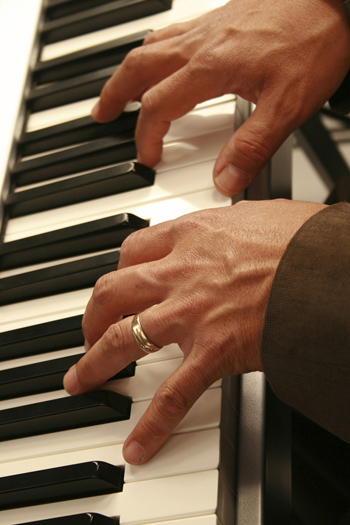
J. Murray Gibson -- m.gibson@neu.edu
Professor of Physics
Dean of the College of Science
Northeastern University
360 Huntington Avenue,
Boston, MA 02115
Popular version of paper 3aMU1
Presented Wednesday Morning,October 24, 2012
164th ASA Meeting, Kansas City, Missouri
The connection between science and art is more intimate than many realize - both science and art rely on the creative impulse, but work within a rigorous framework of natural laws. The science of acoustics widely informs the design of musical instruments like the guitar, but less widely known is the degree to which science and mathematics influence the evolution of musical styles. "The blues" is a great example.
The sumptuous "blue notes," which are rendered naturally by a horn, are not on the keyboard of the modern piano; so piano blues evolved idioms to create the effect of blue notes. But before discussing the blue notes, it's important to understand the musical scale.
MUSIC BY THE NUMBERS
Nearly 3,000 years ago, Pythagoras constructed the first known scale from scratch, adding one note to the next whose wave frequencies had the ratio 3:2, known as a fifth. The resulting pentatonic scale consisted of notes like C, G, D, A and E.
Keep adding fifths and you get the classic diatonic scale we all remember from "The Sound of Music" (do, re, mi, fa, sol, la, ti). The problem with this approach is that if you continue to add perfect fifths, you will never join Maria back at "do." After seven notes, you are within one percent of the original frequency. To get closer, you must add dozens more notes - far too unwieldy for the human musician. So, the seven-note diatonic scale gained favor.
A NEW SCALE
Then, four centuries ago, Bach was born. At the time, if pianos were tuned to the key of D, songs composed in the key of E sounded terrible. But Bach and his contemporaries wanted more complexity in their compositions and a broader palette with which to shift between keys inside a single fugue or cantata. To overcome the impossibility of re-tuning instruments mid-song, a new "well-tempered" scale emerged. Originally perceived as "the Devil's scale," it required each key to a small amount, so that music in all keys sounded similar if very slightly out-of-tune. This creatively-driven compromise worked well for a long while, but this tempering left out an important note - the blue note.
THE BIRTH OF THE BLUE NOTE
Centuries after Bach, Jelly Roll Morton and his contemporaries wanted to bring African sounds into western music using the existing scale. In the key of C, the blue note resides somewhere between E flat and E, where no piano key exists. To get there, the original blues pianists invented the technique of "crushing" notes together - playing E flat and E simultaneously. Crushing was an effort to get at a note that is missing from our "sophisticated" Western scale.
 |
SCIENCE AND MUSIC
The impossible problem of building the "perfect" musical scale is mathematically related to the incongruity between even and odd numbers, yet the compromises necessary in scales have given rise to many rich musical styles, just as inadequacies of old-fashioned Marshall Amplifiers fashioned the unique sound of Jimi Hendrix. The relationship between art and science is intimate and reveals that creativity thrives in constraints. You can't really hate math if you love music!